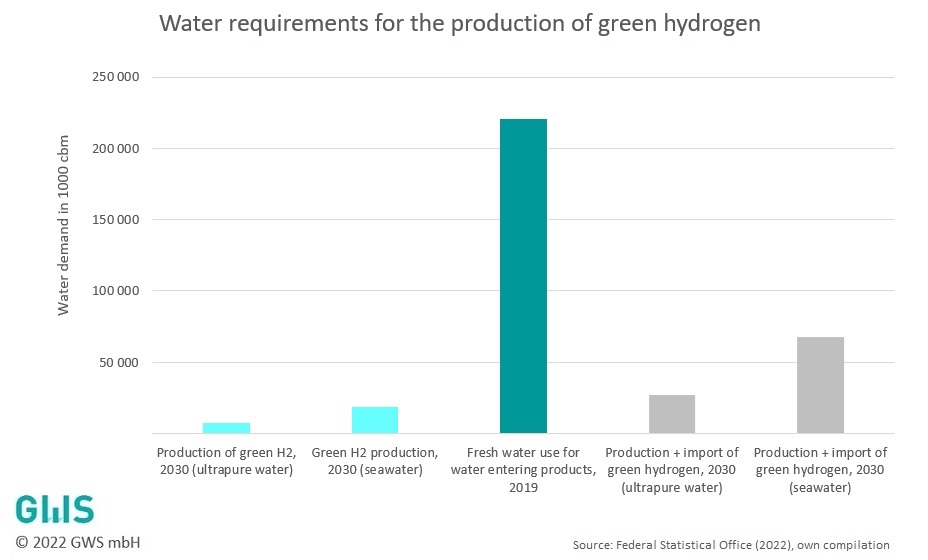Our figure of the month 10/2022: No water shortages expected from hydrogen production in Germany
The National Hydrogen Strategy formulates the goal of a production capacity of 10 GW of green hydrogen by 2030[1]. Although the discussion about the production of green hydrogen often focuses on the sufficient availability of electricity from renewable energies, the production of hydrogen by means of water electrolysis also requires water in addition to electricity. In concrete terms, 9 litres of water are needed to produce 1 kg of hydrogen. This must be so-called "demineralised ultrapure water". Due to the treatment of raw water that is thus necessary, the actual demand is probably even higher – for example, the demand for saline seawater would rise to 22.5 litres per kg of hydrogen[2].
Assuming an electrolyser efficiency of 70 % and 4000 annual full load hours, a production capacity of 10 GW would mean a water demand of approx. 7.6 million m3 ; or 19 million m3 if only seawater were used.

The graph shows these two possible demands in 2030 compared with the fresh water use for water entering products in 2019, which according to the Federal Statistical Office was approx. 220.5 million m3. [3] However, it only accounts for 1.4% or 15.3 billion m3 of the total water use in the economy – excluding public water supply operations. Taking these figures into account, the chart makes it clear that water shortages are not to be expected as a result of the ramp-up of a "hydrogen economy". Especially since some of the water currently used (e.g. by coal-fired power plants) could be substituted by hydrogen.
In general, however, it is assumed that with a production capacity of 10 GW only about 30 % of the total demand for green hydrogen in Germany can be met and thus has to be imported. Accordingly, the graph also shows the water requirements of the total amount of green hydrogen forecast to be needed in 2030 – around 27 million m3 and 67.5 million m3 respectively, depending on the water quality. In contrast to Germany, water shortages may occur in possible export countries, such as the already dry countries of the MENA region, due to the production of large quantities of hydrogen. Accordingly, these and other possible negative externalities should be considered when importing hydrogen. This is addressed, among others, in a publication of the project "Labour demand and labour supply along the value chain 'hydrogen'". Further information on the project can be found here.
Other figures can be found here.
[1] Federal Statistical Office (2022): Frischwassereinsatz: Bundesländer, Jahre, Wassernutzung. Verfügbarer Zeitraum: 2007–2019, GENESIS online, Tabelle 32221-0004. https://www-genesis.destatis.de/genesis//online?operation=table&code=32221-0004&bypass=true&levelindex=0&levelid=1663747447302#abreadcrumb, abgerufen am 29.09.2022.
[2] Federal Ministry for Economic Affairs and Energy (BMWi) (2020): Die Nationale Wasserstoffstrategie. Berlin. https://www.bmwk.de/Redaktion/DE/Publikationen/Energie/die-nationale-wasserstoffstrategie.pdf?__blob=publicationFile&v=20, abgerufen am 29.09.2022.
[3] Jones, E., Qadir, M., van Vliet, Michelle T. H., Smaktin, V. & Kang, Seong-mu (2019): The state of desalination and brine production: A global outlook. Science of The Total Environment 657, pp. 1343–1356. https://www.sciencedirect.com/science/article/abs/pii/S0048969718349167?via%3Dihub.

